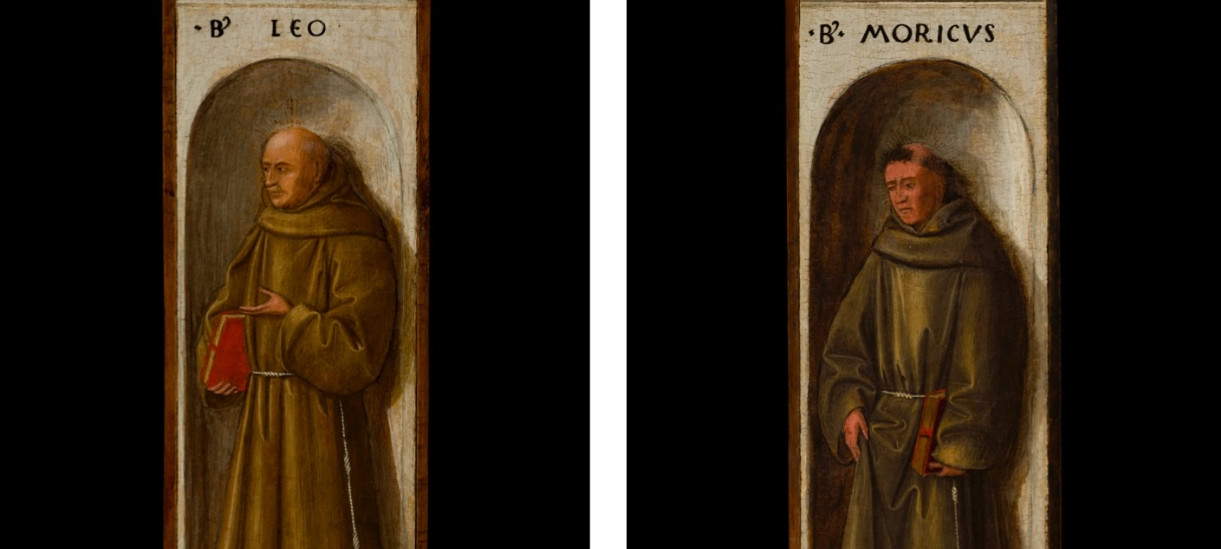The Capodimonte Museum and Real Bosco in Naples welcomes to its collections two precious tablets depicting the Franciscan Blesseds Morico and Leone, masterpieces by Colantonio, the greatest exponent of 15th-century Neapolitan painting and ’master’ of Antonello da Messina. Purchased by the Ministry of Culture (General Directorate for Architecture, Fine Arts and Landscape), these works now become part of the collections of the Neapolitan museum, thus joining two celebrated great works by Colantonio already part of Capodimonte’s heritage: the St. Jerome in his study and the St. Francis delivering the rule to the friars and Poor Clares. These paintings, along with the ten Franciscan Blesseds depicted on the side pillars, were part of a monumental altarpiece originally placed on the altar of St. Jerome in the church of San Lorenzo Maggiore in Naples.
The dismemberment of the polyptych took place around 1639: the St. Jerome was moved to the church sacristy, while the St. Francis became an altarpiece for the Baroque chapel. With the Napoleonic suppression of monastic orders, the St. Jerome entered the Capodimonte Museum in 1808, followed by the St. Francis in 1922. The tablets with the Franciscan blessed, on the other hand, took the path of private collecting.
The two “beatini” will be on display starting Dec. 13 in Room 67, next to the St. Jerome. The St. Francis, on the other hand, is currently being restored as part of Intesa Sanpaolo’s Restitutions project.
To date, of the ten tablets identified, eight are still in private collections. These include Blessed Pietro, Galbazio, Silvestro, Raniero and Maffeo in the Cini Collection in Venice; Blessed Egidio at the Longhi Foundation in Florence; Blessed Giovanni at the Museo Morandi in Bologna; and Blessed Leonardo in a private collection in New York.
Colantonio, active in Aragonese Naples, trained under the influence of Flemish painting, favored by the presence of King Renato of Anjou and Nordic artists such as van Eyck and van der Weyden. The great polyptych for San Lorenzo Maggiore, made around 1444-45 for Alfonso the Magnanimous, represents one of his most significant works, as it highlights the fusion of Flemish tradition and Mediterranean culture. In his workshop, Colantonio had among his pupils Antonello da Messina, who according to some scholars may have collaborated on some of the tablets of the Franciscan blessed.
In addition to the St. Jerome and St. Francis, Capodimonte holds two other important works by Colantonio: the Deposition from the Cross (c. 1455), from San Domenico Maggiore, and thePolyptych of St. Vincent Ferrer (1456-1457), painted for San Pietro Martire.
“We thank the Ministry of Culture for this important acquisition that aims to recompose in Capodimonte, as far as possible, the altarpiece of San Lorenzo Maggiore by the Neapolitan artist Colantonio, an absolute protagonist of painting at the time of Renato d’Anjou (1438-1442) and Alfonso the Magnanimous (1442-1458),” said Capodimonte Museum and Royal Wood Director Eike Schmidt. “It is our intention to enhance more and more the art of the southern 1400s, when courts with a European scope, first the French Angevin and then the Spanish Aragonese, brought together the Flemish Renaissance with the central Italian, Provence and Burgundy with Spain, creating from Naples a Mediterranean cultural unity.”
 |
| Two works by Colantonio enrich the collections of the Capodimonte Museum and Royal Woods |
Warning: the translation into English of the original Italian article was created using automatic tools. We undertake to review all articles, but we do not guarantee the total absence of inaccuracies in the translation due to the program. You can find the original by clicking on the ITA button. If you find any mistake,please contact us.